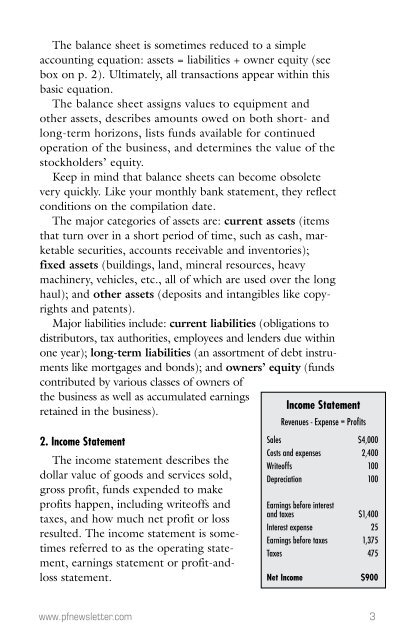Analyze Investments
Analyze Investments
Analyze Investments
Create successful ePaper yourself
Turn your PDF publications into a flip-book with our unique Google optimized e-Paper software.
The balance sheet is sometimes reduced to a simple<br />
accounting equation: assets = liabilities + owner equity (see<br />
box on p. 2). Ultimately, all transactions appear within this<br />
basic equation.<br />
The balance sheet assigns values to equipment and<br />
other assets, describes amounts owed on both short- and<br />
long-term horizons, lists funds available for continued<br />
operation of the business, and determines the value of the<br />
stockholders’ equity.<br />
Keep in mind that balance sheets can become obsolete<br />
very quickly. Like your monthly bank statement, they reflect<br />
conditions on the compilation date.<br />
The major categories of assets are: current assets (items<br />
that turn over in a short period of time, such as cash, marketable<br />
securities, accounts receivable and inventories);<br />
fixed assets (buildings, land, mineral resources, heavy<br />
machinery, vehicles, etc., all of which are used over the long<br />
haul); and other assets (deposits and intangibles like copyrights<br />
and patents).<br />
Major liabilities include: current liabilities (obligations to<br />
distributors, tax authorities, employees and lenders due within<br />
one year); long-term liabilities (an assortment of debt instruments<br />
like mortgages and bonds); and owners’ equity (funds<br />
contributed by various classes of owners of<br />
the business as well as accumulated earnings<br />
Income Statement<br />
retained in the business).<br />
Revenues - Expense = Profits<br />
2. Income Statement<br />
The income statement describes the<br />
dollar value of goods and services sold,<br />
gross profit, funds expended to make<br />
profits happen, including writeoffs and<br />
taxes, and how much net profit or loss<br />
resulted. The income statement is sometimes<br />
referred to as the operating statement,<br />
earnings statement or profit-andloss<br />
statement.<br />
Sales $4,000<br />
Costs and expenses 2,400<br />
Writeoffs 100<br />
Depreciation 100<br />
Earnings before interest<br />
and taxes $1,400<br />
Interest expense 25<br />
Earnings before taxes 1,375<br />
Taxes 475<br />
Net Income $900<br />
www.pfnewsletter.com<br />
3




